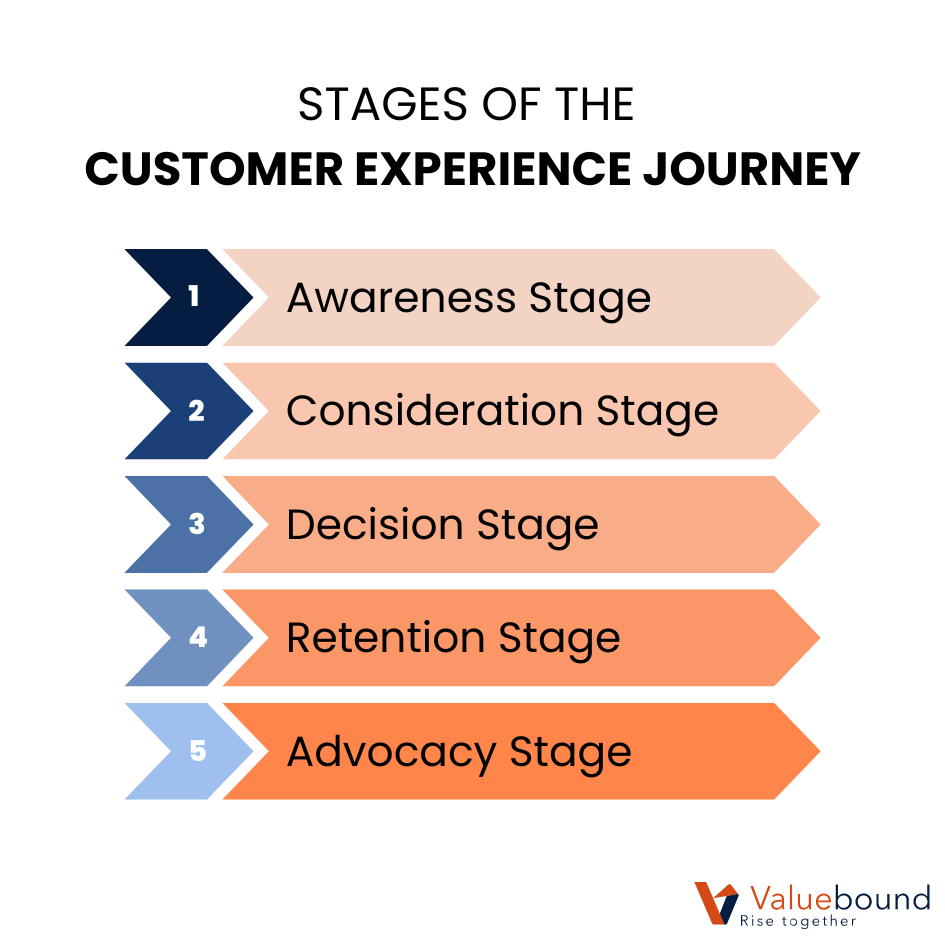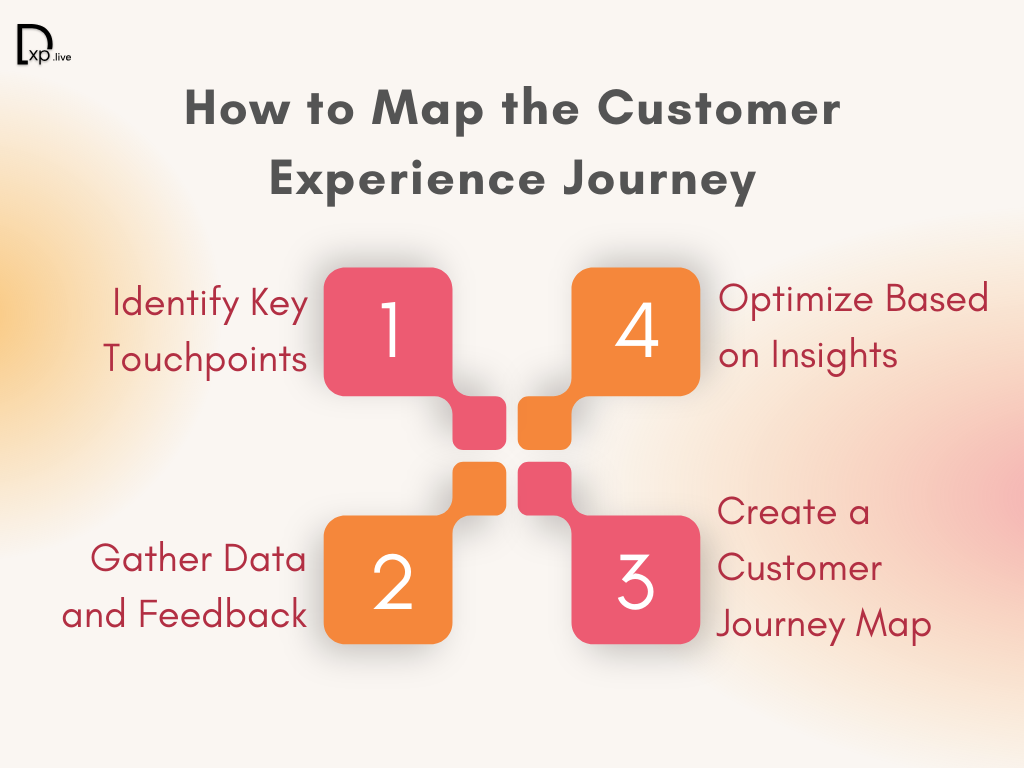The customer experience journey is the business pathway that effectively shapes how customers perceive and engage with your brand. There's a need to understand that because it provides insights into knowing what is needed and expected by the customer. Businesses can identify pain points, which improves interactions that can shape experiences when mapping out every stage.
At Valuebound, we focus on delivering exceptional value by always aiming to exceed customer expectations. We believe that understanding and improving the customer experience journey is essential for success.
In this blog, we’ll explore what the customer experience journey is, how mapping it can uncover pain points, and why this process is crucial for any business undergoing digital transformation. We’ll also break down the stages of the customer journey and provide real-world examples of businesses that excel at delivering exceptional customer experiences.
What Is the Customer Experience Journey?
The customer experience journey is the entire path a customer takes when interacting with your brand, from first hearing about your business to what happens after they make a purchase. It’s not just about the steps they take to buy something—it’s about how they feel at each stage, whether their needs are met, and if they’ll stick with your brand or recommend it to others.
By understanding and mapping this journey, businesses can make sure customers have a smooth and consistent experience at every point and spot areas where things can be improved.
Examples of Customer Experience Journey
In this digitalization, customers want to feel recognized, valued, and understood, whether they’re interacting with your brand via a chatbot, a website, or in person. Disjointed or disconnected experiences can cause frustration, lead to lost sales, and weaken customer loyalty.
Here are the perfect examples of customer experience journey mapping:
- Amazon is one of the best examples of the companies that map and optimize the customer experience journey. The personalization of recommendations, quick checkout options, and outstanding post-purchase support ensure a loyal and engaged customer at every touch point.
- Spotify uses its customer journey map to analyze listener behavior in delivering personalized playlists, recommendations, and cross-device experiences so that the users remain hooked to the app.
How to Improve the Customer Experience Journey
To enhance the customer experience journey, businesses should take a proactive approach by following these steps:
- Use Data Analytics: Utilize data analytics tools for tracking customer behaviors and preferences. Analyzing this data allows businesses to make informed decisions and tailor experiences to meet customer expectations effectively.
- Customer-Centric Culture: Every organization level needs to have a customer experience-focused culture. Encourage teams to adopt the 'customer needs' and talk about receiving feedback in return and find out what changes can be made in interaction with customers.
- Invest in Training: Equip your staff with the necessary skills to address customer concerns and deliver exceptional service at every touchpoint.
- Utilize Technology: Implement the resources that make the customer journey easier using CRM systems, chatbots, and analytics tools to make processes simpler and communicate better.
These approaches have the potential to create a smoother and more meaningful customer experience journey that will lead to higher levels of satisfaction, loyalty, and excellence overall.
Why Customer Experience Journey Mapping Is Crucial
Knowing the customer experience journey is valuable for any business undergoing digital transformation. Why? Digital transformation is more than adopting new technologies; it's about transforming how you interact with your customers in a seamless experience across channels and meeting them where they are.
Common pain points during digital transformation include:
- Disconnected customer experiences because departments or systems are siloed
- Messaging across channels is inconsistent
- Failure to answer customer doubts or complaints
- A lack of personalization in the customer journey
Customer journey mapping can help an organization identify these pain points and, hence develop specific areas for focus that can militate against them. By streamlining processes and presenting consistent, good-quality interaction at every step of the customer journey, businesses are creating loyal customers who will likely stick around for the long term.
Stages of the Customer Experience Journey

Mapping the customer experience journey requires identifying the key stages where customers interact with your brand. These stages may vary depending on the business or industry, but they generally follow this path:
1. Awareness Stage
The customer becomes aware of your product or service. This can happen through ads, social media, word of mouth, or organic search. At this point, the customer is exploring options and gathering information.
Example: A potential customer sees an ad for your product on Instagram and decides to research your brand further.
2. Consideration Stage
During this stage, the customer is evaluating whether your product or service meets their needs. They may compare different brands, read reviews, and seek advice from peers before making a decision.
Example: A customer visits your website, reads blog posts, checks product details, and watches product demos to understand how your solution could solve their pain points.
3. Decision Stage
Here, the customer is ready to make a purchase decision. This stage requires businesses to ensure that the purchasing process is smooth and that the customer feels confident about their choice.
Example: The customer adds your product to their cart, reads a few testimonials for reassurance, and completes the purchase.
4. Retention Stage
Post-purchase, businesses must ensure that customers have a positive onboarding experience and remain satisfied with the product or service. At this stage, companies often provide support and follow-up to ensure the customer is happy with their purchase.
Example: The customer receives a personalized onboarding email, regular updates on product usage, and access to customer support for any questions.
5. Advocacy Stage
A satisfied customer will naturally become a brand advocate, promoting your business to friends, family, and colleagues. Encouraging this behavior by creating incentives for referrals or sharing positive experiences can solidify brand loyalty.
Example: A happy customer writes a glowing review, shares their experience on social media, or refers new customers to your business.
How to Map the Customer Experience Journey

Mapping your customer experience journey is a process that requires empathy, data, and a deep understanding of your customers’ needs. Here’s how to approach it:
1. Identify Key Touchpoints
Begin by identifying all the potential touchpoints where customers interact with your brand—both online and offline. This can include social media channels, website visits, customer service interactions, in-store visits, and more.
2. Gather Data and Feedback
Collect data on how customers behave at each touchpoint. Surveys, focus groups, and customer feedback can provide insights into their experience and where friction occurs.
3. Create a Customer Journey Map
A journey map visually represents the stages of the customer’s experience with your brand, highlighting moments of satisfaction and pain points. This can help your team identify where the journey needs improvement.
4. Optimize Based on Insights
Use the insights from your journey map to optimize each stage of the customer experience. This may involve enhancing digital channels, improving customer support, or ensuring messaging consistency across platforms. Example: Offering free shipping for purchases over a certain amount significantly reduces cart abandonment rates.
In a Nutshell
The journey your customers take with your brand can make or break your business. By mapping the customer experience journey, identifying key touchpoints, and optimizing every stage of interaction, you can create a smoother, more personalized experience that not only meets but exceeds customer expectations.
At Valuebound, we specialize in helping businesses like yours navigate the digital transformation landscape by focusing on customer-centric solutions. Our commitment to exceeding expectations means we’ll work with you to map and improve your customer experience journey, ensuring your customers stay loyal and satisfied.
Ready to transform your customer experience journey? Contact our experts at Valuebound today and start delivering the seamless, personalized experiences your customers expect.
FAQs
- What is a customer experience journey?
The customer experience journey is the complete series of interactions a customer has with your brand, from initial awareness to post-purchase.
- Why is mapping the customer experience journey important?
Mapping helps businesses identify pain points and improve touchpoints to ensure a seamless, satisfying experience for customers.
- What are the key stages of the customer experience journey?
The journey typically includes awareness, consideration, purchase, retention, and advocacy, each representing a crucial interaction point.
- How can businesses use journey mapping to enhance customer satisfaction?
By understanding and optimizing each stage of the journey, businesses can create more personalized, consistent experiences that build loyalty.
- What tools can help map the customer experience journey?
Tools like customer feedback surveys, analytics platforms, and journey mapping software can assist in gathering insights and visualizing the journey.




